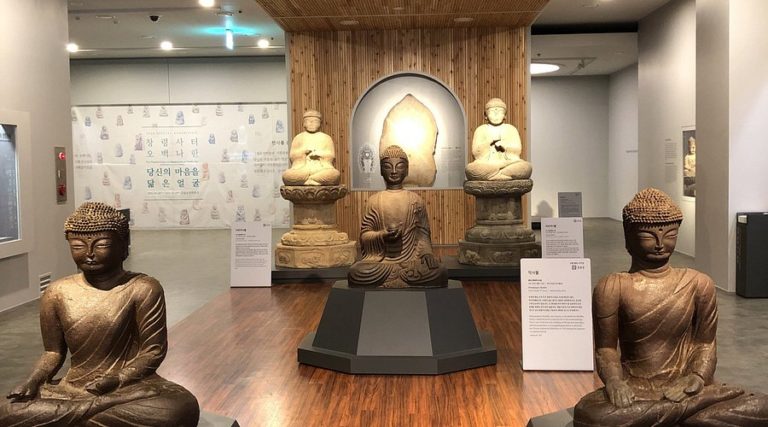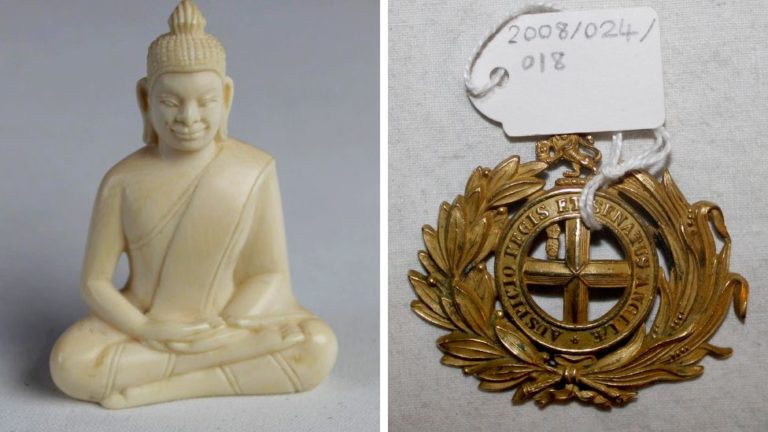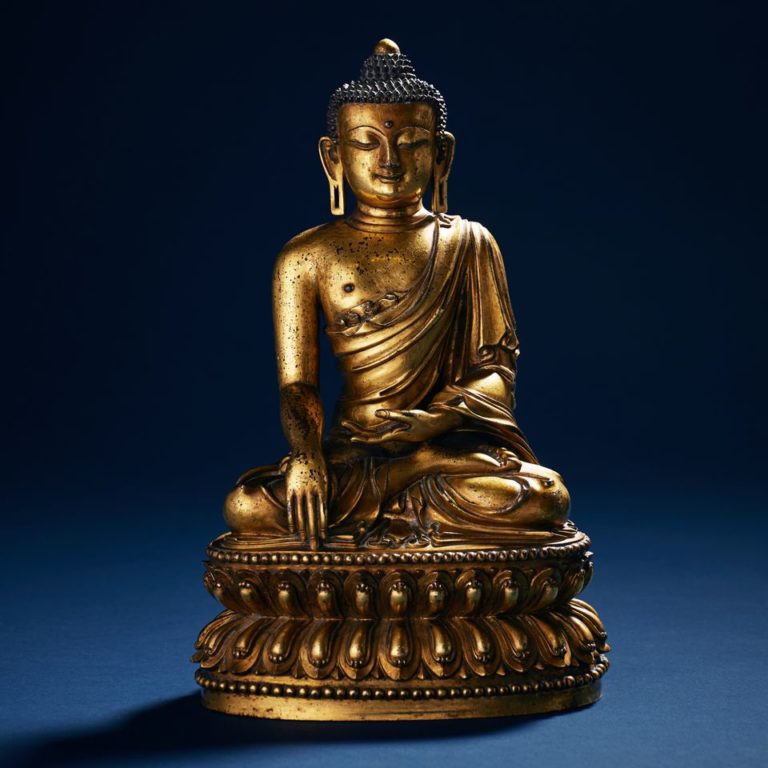
Buddha Shakyamuni, 9th century, Sri Lanka,
Gift of Joan Palevsky and the Museum Acquisition Fund (M.76.46)
South and Southeast Asian Art, Los Angeles County Museum of Art (LACMA)
When most of us think of Buddhism, we likely won’t immediately think of it as “a teaching of images,” and yet, in the early period of the transmission of Buddhism to China, we come across Chinese references to Buddhism as exactly that. Even if we have been personally touched by a sense of serenity and well-being radiating from Buddha statues, we may not primarily associate Buddhism with imagery. Many think of Buddhism as a tradition centered on meditative or contemplative practices. Or, it’s the often-heard notion, “it’s a philosophy,” alongside the more contemporary argument, “it’s a science of the mind.” But all Buddhist cultures throughout the spread of the tradition across Asia and now to the West have developed a rich material culture centered on Buddha images.
Some early Chinese sources characterized Buddhism as “xiang jiao”—literally the “teaching” or even “religion” (jiao) of “images” (xiang). And it was this aspect—Buddhist images—that caught the attention of the Chinese in the second century. In fact, the various stories of the spread of Buddhism from India outward to other parts of Asia always involved the movement of Buddhist images—statues, paintings—and other such objects as holy remains (i.e. relics), ritual objects, and sacred books. While xiang jiao was likely used to highlight the “foreignness” of Buddhism in China and xenophobic in origin, we mustn’t deny the central role of images in Buddhism, past and present.
Just as the physical body and later statues of the Buddha have power—power to remind Buddhists of the Buddha and his qualities, power to instruct, power to inspire, and even to protect—Buddhist scriptures that arrived in various new lands were cherished as much for their materiality as for the liberative teachings they carried. Buddhist scriptures were, first and foremost, material objects that radiated powers of protection, merit, and blessings.
We can appreciate how all Buddhist cultures throughout the spread of Buddhism have expressed and responded to the power of images. That we in the West do not so readily consider the use of images as a central aspect of Buddhist practice tells us more about our current context than of the Buddhist tradition itself. The ancient Chinese observation (or labeling) of Buddhism as a “religion/teaching of images” is instructive and potent in our own practice. Buddha images are, in fact, intended as images of the awakened state. Buddha images became images of the historical Buddha, Shakyamuni, only when he was no longer available as a physical presence. They imaged the Buddha.
All Buddhist traditions agree that all buddhas possess a unique set of physical features codified as the 32 major and 80 minor physical characteristics indicative of a set of 112 inner qualities Several sutras give the correspondences between a particular physical mark of a buddha’s form with a specific inner quality. The physical form of a buddha thus becomes a window that allows us to perceive the inner qualities of a buddha. Thus, to see a buddha is to see the buddha-qualities. To see a buddha’s marks is to see the dharma. The physical marks and signs that Shakyamuni Buddha had can be understood as the original “image” of timeless awakening in so far as they imaged the inner good qualities that were otherwise unavailable to untrained and casual onlookers. For every person who saw the historical Buddha and realized the significance of what they were seeing and acted upon what they saw, there were many others who did not see Siddhartha, the “drop-out prince,” as someone special—much less “awakened” or “enlightened.” Siddhartha’s temporal embodiment of the timeless awakened state was available to those fortunate enough to be born at the right place and right time due to their store of good karma ripening at an opportune moment. Those who were born and lived in the Central Indian Gangetic plains at the time of the historical Buddha thus saw and heard him and, most importantly, understood what they were seeing and hearing. After his passing, when the historical Buddha was no longer available as a physical presence, his relics (cremated remains) and, later on, Buddha statues served as a representation of the timeless Awakened state. As material culture developed in India, so did Buddhist material culture in the form of Buddha images. Earlier material devices that suggested the presence of the Buddha, such as an empty throne—the irony of highlighting the apparent absence of the Buddha to signal the ultimate presence of the Buddha—as well as bodhi trees, idealized footprints of the Buddha, or the eight-spoked dharma-wheel would become overshadowed by the proliferation of Buddha images.
Beyond Buddha statues as images of the awakened state, Buddhist scriptures in the form of physical texts are likewise images of the Dharma. The visual shapes of the words first written and later printed on paper are manifest and temporal images of the unchanging dharma that is otherwise hidden from our currently obscured mind. Just as the physical body and later statues of the Buddha have power—power to remind Buddhists of the Buddha and his qualities, power to instruct, power to inspire, and even to protect—Buddhist scriptures that arrived in various new lands were cherished as much for their materiality as for the liberative teachings they carried. Buddhist scriptures were, first and foremost, material objects that radiated powers of protection, merit, and blessings. In particular, Mahayana sutras such as the Lotus Sutra and the various sutras of the Perfection of Wisdom genre contain copious descriptions and prescriptions for relating to them as potent material objects of veneration and adoration. Sutras dedicated to dharani-incantations especially extol the power of not only the sounds of the dharani when vocalized but also the power of the materiality of these dharanis: one is to copy, carve, and engrave these dharanis onto cloth, pillars, and stupas so that they can bring both spiritual and worldly benefit. In the Pali tradition, there is the practice of writing verses of protection known as parittas on paper, fabric, and copper sheets so that they can be worn on one’s body as protection. The tradition of sak yant or sacred tattoos in mainland Southeast Asian Buddhist cultures turns believers’ bodies into the medium for inscribing powerful bits of dharma texts. Meanwhile, in Mahayana sutras and dharanis, we are enjoined to enshrine them, circumambulate them, and make offerings of light, incense, flowers, fabric, and perfume to them. Dharma texts are images of the changeless dharma and therefore carry the power of the changeless dharma in them. In fact, dharma texts should also be enshrined in stupas as they are “dharmakaya relics” and, in some contexts, considered even more potent than the actual physical (i.e. nirmanakaya) relics of the historical Buddha or his great disciples.
Seeing the Buddha and seeing the dharma thus become possible through Buddha statues and dharma texts. The Buddha famously consoled his disciples as he was nearing his own death by telling them that “whoever sees the Dharma sees me, and whoever sees me sees the Dharma.” Seeing the dharma is seeing the Buddha, and likewise, seeing the Buddha is seeing the dharma. And seeing both is made possible for us all through images. So perhaps it should not be so surprising to me—or you— that so many new Buddhists or Buddhism-friendly people whom I have met have mentioned seeing a Buddha image as an initial but consequential encounter with the Dharma. They saw the Buddha and, in time, saw the dharma. And in seeing the dharma, they see the Buddha.




